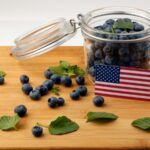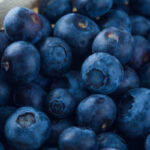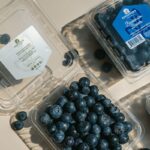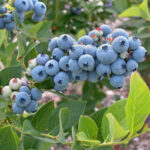A guide to home growing blueberries in Florida

The purpose of this publication is to provide home gardeners with basic information on growing blueberries in Florida. Commercial growers and those interested in more detailed information on growing blueberries in Florida are encouraged to visit the UF/IFAS Extension publications website at https://edis.ifas.ufl.edu/topic_blueberry.
Florida's winter season is short and mild with intermittent periods of warm temperatures. Most deciduous fruit cultivars have high chilling requirements and do not grow well in Florida. To produce optimum fruit yield and quality, most deciduous fruit cultivars require more exposure to temperatures below 45ºF during the winter than they are likely to experience in Florida.
With insufficient chilling, plants do not flower and leaf out satisfactorily during the spring. Growth can be weak and erratic. However, low-chill cultivars of some deciduous fruits, including blueberry, have been developed by plant breeders at the University of Florida and elsewhere. These cultivars were developed specifically for regions with mild winter temperatures such as in north and central Florida.
Two types of blueberries grow well in Florida, rabbiteye (Vaccinium virgatum) and southern highbush (interspecific hybrids of V. darrowii, V. virgatum, and V. corymbosum). However, only the low-chill cultivars of each are adapted to Florida. Generally, rabbiteye blueberries grow well in areas of Florida that have winters as cold as or colder than winters in Ocala.
The southern highbush cultivars that are commonly grown in Florida are well adapted to areas south of Ocala and north of Sebring, although they will grow reasonably well in Alachua County. The southern limits of southern highbush adaptation in Florida have not been fully determined.
Site requirements for growing blueberries
Both rabbiteye and southern highbush thrive on acidic soils, which contain more organic matter than is usually found in Florida soils. If mulched, rabbiteye blueberries will usually grow satisfactorily on soils with 1% organic matter, but they perform better with soils that have 2–3% organic matter.
Southern highbush cultivars are not recommended for soils with less than 3% organic matter unless additional organic matter is added as a soil amendment and mulches are added to the site. Peat moss or pine bark is commonly used to increase soil organic matter in blueberry plantings. Peat moss can be incorporated into the soil at or prior to planting. Pine bark can also be mixed into the soil, or when applied as mulch it will eventually decompose and add to the soil organic matter content. In areas where blueberry plants have been heavily mulched for several years, it is not uncommon to observe most of the fibrous roots growing in the decomposed litter above the natural soil.
Blueberries require a soil pH of 4.0–5.5. At higher soil pH values, tissue levels of microelements such as iron and zinc become deficient. Deficiency symptoms develop on new growth, and plants lose vigor. Soil can be acidified by thoroughly mixing a small amount of granulated sulfur into the soil several months before planting. Many fertilizers are acid-forming and will gradually lower the soil pH. A soil test is needed to measure the soil pH and can help to determine whether or not acidification of the soil is necessary. Your local county Extension office can assist you with proper soil testing procedures.
Blueberries require a well-drained soil profile of at least 18 inches in depth. Blueberries should be planted on raised beds if water drainage is poor (within 18 inches of the soil surface for prolonged periods during the rainy season). If blueberry roots are exposed to water-saturated soil for more than a few days, damage from Phytophthora root rot may become severe. Generally, blueberries will grow well where azaleas, camellias, and other "acid-loving" plants are proven performers.
Set plants in a sunny area (at least 4–5 hours of full sun per day) away from the roots of trees except pines and at least 20 feet away from any building foundation. A mature rabbiteye blueberry plant can reach 12–15 feet in height with canes sprouting over an area of 8–10 feet in diameter. Southern highbush plants tend to be less vigorous and smaller than rabbiteyes. Plant size can be controlled to some degree by pruning. However, severe pruning will reduce yields the following spring. Allow at least a 7' x 7' area for rabbiteyes and a 4' x 4' area for southern highbush. Plants may be set 3 feet apart (southern highbush) or 5 feet apart (rabbiteye) for a hedgerow effect.
Planting and establishment for growing blueberries
The best time to plant blueberries is from mid-December to mid-February. Bare-root or container-grown plants can be used. It is best to use plants about 1.5 to 2 feet tall with well-developed root systems that are not pot-bound. Keep the roots of bare-rooted plants moist but not overly wet prior to and during planting. The root balls of potted plants should be broken up slightly and the roots of bare-rooted plants should be spread out evenly in the planting hole.
In most situations, dooryard blueberry plants benefit from the incorporation of 1/4–1/2 cubic foot of acid sphagnum peat moss into the planting hole. Dig the hole large enough to accommodate the roots and peat moss. The plants should be set at the same height as when they were growing in the nursery. If blueberries are planted on raised beds, flatten the bed in the vicinity of the plants and set the plant in a slight depression so that irrigation and rain water will not flow away from the plant.
Pine bark mulch aids in the establishment of young blueberry plants. Either a layer of pine bark 3 inches deep extending about 2 feet out from the plants in all directions or a pine bark strip about 4 feet wide extending down the row will provide a good substrate for surface feeder roots.
Mulch also moderates soil temperatures, aids in weed control, provides protection from mechanical injury, and adds organic matter to the soil. Weed control is extremely important for young plant establishment because blueberries are shallow-rooted plants that compete poorly with weeds for water and nutrients.
Blueberries should be pruned at the time of planting. If plants have a well-developed root system and irrigation is used, pruning should not be severe. Select the tallest, strongest cane and leave it unpruned.
Remove the weak, "twiggy" growth at the base of the plant. If the plant has a large top compared with the root system, remove about one-third of the top by selectively pruning the least vigorous growth and cutting back the tops of vigorous canes by several inches. During the first growing season, remove all flowers before fruit set occurs. This will prevent fruiting during the first year and promote strong vegetative growth and good plant establishment. This is especially important with some southern highbush cultivars that flower heavily as young plants.
Cultivars
Aside from site selection, choosing the proper blueberry cultivars may be the most important decision a dooryard blueberry grower can make. Most blueberry cultivars grown in Florida are self-unfruitful; they require cross-pollination from another cultivar of the same type (southern highbush with southern highbush and rabbiteye with rabbiteye). Another requirement for good fruit set is that pollen vectors (usually bees) are present and working the flowers during bloom. With good pollination, berry yields of 2–5 pounds per plant may be expected by the third or fourth year. Some of the major blueberry cultivars commonly grown in Florida are described below.
Southern Highbush Cultivars. Southern highbush blueberries grown in peninsular Florida are the earliest blueberries to ripen in North America. These cultivars are generally considered more difficult to grow than rabbiteye types. Very early flowering makes southern highbush cultivars quite susceptible to late winter/early spring freezes and therefore not suited for extreme north and northwest Florida. Moreover, southern highbush blueberries are less forgiving of soil requirements and are generally more susceptible to some diseases such as Phytophthora root rot. However, in central or south Florida, southern highbush cultivars are preferred over rabbiteyes. The following is a list of the more common southern highbush cultivars available in Florida. All of the southern highbush cultivars described below are patented releases from the University of Florida breeding program. For a current listing of nurseries licensed to propagate and sell each of these cultivars, contact the Florida Foundation Seed Producers at (352) 392-9446 or look online at http://ffsp.net.
'Emerald' was released by the University of Florida in 1999 and is currently one of the more widely planted cultivars in north and central Florida. It appears to be adapted from Gainesville to Sebring. 'Emerald' combines a vigorous, spreading bush with high yield potential, early ripening, and large, high-quality berries. 'Emerald' flowers open uniformly, and it produces abundant leaves even after mild winters in Gainesville. Because the plant is highly vigorous when planted on suitable soils, 'Emerald' is capable of carrying heavy crops. 'Emerald' normally reaches full bloom in Gainesville around February 15, thus flowers and fruit require protection from freezes in February and March. In Gainesville, first harvest occurs a few days earlier for 'Emerald' than for 'Sharpblue' and 'Star'. About 80% of the fruit of 'Emerald' is normally ripe between April 15 and May 10 in Gainesville.
'Jewel' was released by the University of Florida breeding program in 1999 and has a moderately low chilling requirement, very early ripening, and high berry quality. 'Jewel' appears to be adapted to the region of Florida from Gainesville to Sebring. In Gainesville, 'Jewel' typically flowers about a week before 'Star' and ripens at approximately the same time as 'Star'. The average harvest date of 'Jewel' in Gainesville is April 12, and harvest is normally finished by May 10. 'Jewel' produces a large number of flower buds but leafs well in the spring. Its vigor is high, which allows it to carry a large crop of high-quality berries. Its berry quality is excellent but tends to be tart until fully ripe. Its berry size is medium to large, its firmness is good to excellent, and its stem scars are dry and considered to be excellent. 'Jewel' is moderately susceptible to Phytophthora root rot and highly susceptible to rust leaf spot disease, which may require fungicide sprays to prevent early fall defoliation.
'Star' was released by the University of Florida in 1995. 'Star' has medium vigor but its survival in the field has been good. 'Star' has a higher chilling requirement than 'Emerald' or 'Jewel' and appears to be best adapted to north Florida and southeast Georgia. 'Star' has not performed well south of Ocala where it shows symptoms of inadequate winter chilling, including few flowers and weak vegetative growth. The average date for 'Star' to reach 50% bloom in Alachua County is February 23. The first half of the crop is normally ripe by April 26. 'Star' leafs out well in Gainesville and southeastern Georgia. 'Star' has a very short bloom to ripe interval and has a relatively compressed harvest period of about 3 weeks. Its berries are excellent in size and firmness, and its stem scar is minimal.
'Windsor' (Figure 4) was released from the University of Florida breeding program in 2001 and is vigorous, with stout stems and a semi-spreading growth habit. 'Windsor' appears to be best adapted to north-central Florida but has been grown successfully as far south as Hardee County. The average date of 50% bloom in Alachua County is February 21, usually several days after 'Emerald' and about 3 days before 'Star'. 'Windsor' leafs out strongly as it begins to flower, and this strong vegetative growth enables it to support a large crop. In Alachua County, fruit usually begin to ripen in early to mid-April, and 50% of the berries are normally ripe by April 24. 'Windsor' berries are very large. Berries from the first half of the harvest average about 2.4 grams on young vigorous plants. The berries are about the same color as those of 'Star'. It has good firmness and excellent flavor. 'Windsor' has a deep picking scar, which complicates packing and reduces commercial postharvest life, but this is generally not a problem for home gardeners.
'Springhigh' is a vigorous, upright cultivar that has exceptionally good survival in the field. 'Springhigh' appears to be adapted to north-central and central Florida. 'Springhigh' ripens about 5–10 days earlier than the standard mid-season cultivars ('Star', 'Windsor', 'Emerald', and 'Jewel'). The berries are very large and have good to excellent flavor. Berries of 'Springhigh' have less waxy bloom on their surfaces, making them darker than most other cultivars. They have only medium-good scars with a tendency for some tearing of the berry skin around the picking scar during harvest. Also, they have only medium firmness, which sometimes presents problems during commercial packing and shipping, but should not be an issue for home gardeners. The berries are very attractive to flower thrips, which in many years are abundant during the weeks when 'Springhigh' is ripening. If thrips populations are not kept very low when 'Springhigh' is beginning to ripen, their damage will soften the berries and reduce berry postharvest storage life.
'Sweetcrisp' is a vigorous plant with good field survival and a spreading growth habit. It flowers about the same time as 'Jewel' (which is later than 'Emerald' and earlier than 'Star' or 'Windsor') and ripens at about the same time as 'Jewel' and 'Emerald'. The berry is sweet with a crisp crunch at the first bite. It is very firm and has exceptional postharvest life. The berries are smaller than those of 'Emerald', 'Star', and 'Windsor', and are variable in size, depending on the diameter of the twigs bearing the flowers. Flower bud number and berry yield in Gainesville are below average (less than most other cultivars), and it appears to be best adapted to north Florida and south Georgia. Because of its exceptional berry quality and postharvest storage, 'Sweetcrisp' has high potential for a garden cultivar in north Florida.
'Farthing' is a vigorous plant with a dense, compact canopy. The leaves tend to be healthy and relatively free of leaf spot diseases. The berries are large and firm, and they have a good picking scar but tend to be dark in color because of low surface wax content. 'Farthing' produces numerous flower buds, and dormant pruning may be required to prevent over-fruiting. 'Farthing' flowers later than most Florida cultivars, but before 'Star' or 'Windsor'. The berries on 'Farthing' generally ripen at about the same time as 'Star', but it produces significantly higher yields than 'Star'. 'Farthing' has performed well in north-central Florida, but it is a new cultivar and its adaptive range has not been fully determined.
Rabbiteye cultivars. Rabbiteye cultivars, as a group, are easier to grow than southern highbush. They are more tolerant to drought and less susceptible to Phytophthora root rot. They flower later in the spring, making them less susceptible to late winter/early spring freezes. They require less organic matter and less mulching, and they are generally more vigorous. Rabbiteye fruit has a slightly tougher skin and slightly larger seed than southern highbush fruit. Fruit from rabbiteye cultivars usually stores better than southern highbush fruit. Rabbiteyes require cross-pollination from another rabbiteye cultivar. The harvest season for rabbiteye blueberries extends from May to July, depending on the cultivar. Rabbiteyes are best adapted to areas of Florida north of Ocala.
'Beckyblue', 'Bonita', and 'Climax' are three early-season rabbiteye cultivars that are widely grown in Florida. These cultivars usually ripen in late May and early June in Gainesville. Early-season rabbiteyes have not been as productive under Florida conditions as the mid- to late-season cultivars. However, they are useful in extending the rabbiteye harvest season. For best pollination, plant 'Climax' with either 'Beckyblue' or 'Bonita'. 'Austin' is a newer early-season rabbiteye cultivar that appears to grow well where 'Climax' is adapted and should cross-pollinate with other early-season rabbiteye cultivars.
Most of the mid- to late-season rabbiteye cultivars are more productive than the early-season rabbiteyes discussed above and are therefore better suited for home gardeners. 'Brightwell', 'Powderblue', 'Tifblue', and 'Woodard' have performed very well in north Florida and in the panhandle. These cultivars bloom later than the early-season rabbiteyes, and the flowers and young fruit are much less susceptible to late winter freezes. Other mid- to late-season rabbiteyes that can be grown in Florida but are less popular and may be harder to locate include 'Chaucer' and 'Bluegem'.
















































